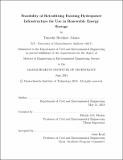| dc.contributor.advisor | Elfatih A.B. Eltahir. | en_US |
| dc.contributor.author | Adams, Timothy Breckner | en_US |
| dc.contributor.other | Massachusetts Institute of Technology. Department of Civil and Environmental Engineering. | en_US |
| dc.date.accessioned | 2018-11-28T15:25:27Z | |
| dc.date.available | 2018-11-28T15:25:27Z | |
| dc.date.copyright | 2018 | en_US |
| dc.date.issued | 2018 | en_US |
| dc.identifier.uri | http://hdl.handle.net/1721.1/119273 | |
| dc.description | Thesis: M. Eng. in Environmental Engineering Science, Massachusetts Institute of Technology, Department of Civil and Environmental Engineering, 2018. | en_US |
| dc.description | This electronic version was submitted by the student author. The certified thesis is available in the Institute Archives and Special Collections. | en_US |
| dc.description | Cataloged from student-submitted PDF version of thesis. | en_US |
| dc.description | Includes bibliographical references (pages 125-134). | en_US |
| dc.description.abstract | Pumped storage is the only mature grid-scale energy storage technology. Originally developed to support nuclear base load plants due to its ability to store energy on the scale of gigawatt-hours (GWh) and rapidly respond to demand fluctuations, pumped storage is recognized as a viable option to support variable renewable sources of energy such as solar and wind. However, in the United States, environmental concerns, regulatory barriers, and high capital costs have effectively prevented the building of new pumped storage facilities for the past 30 years. Instead, developers and researchers have primarily invested their time and resources into pursuing chemical storage options, including lead-acid, lithium-ion, and sodium-sulfur (Na-S) chemistries. These alternative technologies do not have the geographic limitations of pumped storage, but suer from higher costs at grid scales, shorter lifespans, and the negative environmental impacts of mining, manufacturing, and disposing of large quantities of chemicals. Grid-scale storage needs will increase substantially as variable resources like solar and wind supply an increasing fraction of the grid's energy. To address this challenge, we propose a renewed focus on developing large-scale pumped storage facilities at sites with existing reservoirs. This approach avoids the environmental concerns associated with building new dams and reduces regulatory barriers by requiring minimal land-use changes. Retrofitting existing facilities in this way converts their primary purpose to storing electricity generated from other renewable sources such as solar or wind, while still enabling hydroelectricity generation to continue. Such retrofitted systems have already been built in the United States and Europe, proving that an approach of this type is feasible. In order to match the scale of the need, however, significantly more storage capacity is required. Therefore, we propose a widespread adoption of this approach, especially as a potential alternative to chemical storage. To illustrate this concept, we explored the technical feasibility of retrofitting the Big Creek hydropower system in central California (Edison International) by carrying a preliminary technical feasibility study. The Big Creek system is composed of 6 reservoirs and currently supports about 1GW of capacity. We found that by expanding the tunnel network and adding pump-turbines between two of these reservoirs, the Big Creek system could provide 75GWh of energy storage capacity and 5GW of power capacity. These values are large enough to enable complementary solar power to provide 5GW of baseload power in the summer, 25% of the baseload demand for the California Independent System Operator (CAISO). Existing infrastructure would remain untouched, enabling current hydropower generation to continue. Added infrastructure would include 4 tunnels 6m in diameter and approximately 24km in length each, 24 pump-turbines evenly distributed across the 4 powerhouse locations that lie between the reservoirs, additional powerhouses to store the pump-turbines, and 4 500kV transmission lines to transmit the power to either San Francisco or Los Angeles. A preliminary cost analysis for this project estimates costs between $2500-$4000/kW ($12.5-20 billion), in line with current standard estimates of pumped storage costs that demonstrate the superiority of pumped storage to chemical storage alternatives for grid-scale energy time-shifting applications. Future research will include a more comprehensive study of the technical and economic feasibility of adding a large scale pumped storage facility to the Big Creek system. Additionally, we will expand our analysis to cover the scale of the state of California by including other existing hydropower sites. | en_US |
| dc.description.statementofresponsibility | by Timothy Breckner Adams. | en_US |
| dc.format.extent | 134 pages | en_US |
| dc.language.iso | eng | en_US |
| dc.publisher | Massachusetts Institute of Technology | en_US |
| dc.rights | MIT theses are protected by copyright. They may be viewed, downloaded, or printed from this source but further reproduction or distribution in any format is prohibited without written permission. | en_US |
| dc.rights.uri | http://dspace.mit.edu/handle/1721.1/7582 | en_US |
| dc.subject | Civil and Environmental Engineering. | en_US |
| dc.title | Feasibility of retrofitting existing hydropower infrastructure for use in renewable energy storage | en_US |
| dc.type | Thesis | en_US |
| dc.description.degree | M. Eng. in Environmental Engineering Science | en_US |
| dc.contributor.department | Massachusetts Institute of Technology. Department of Civil and Environmental Engineering | en_US |
| dc.identifier.oclc | 1062360948 | en_US |
